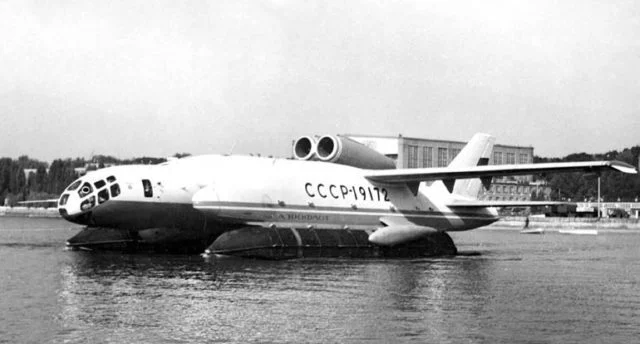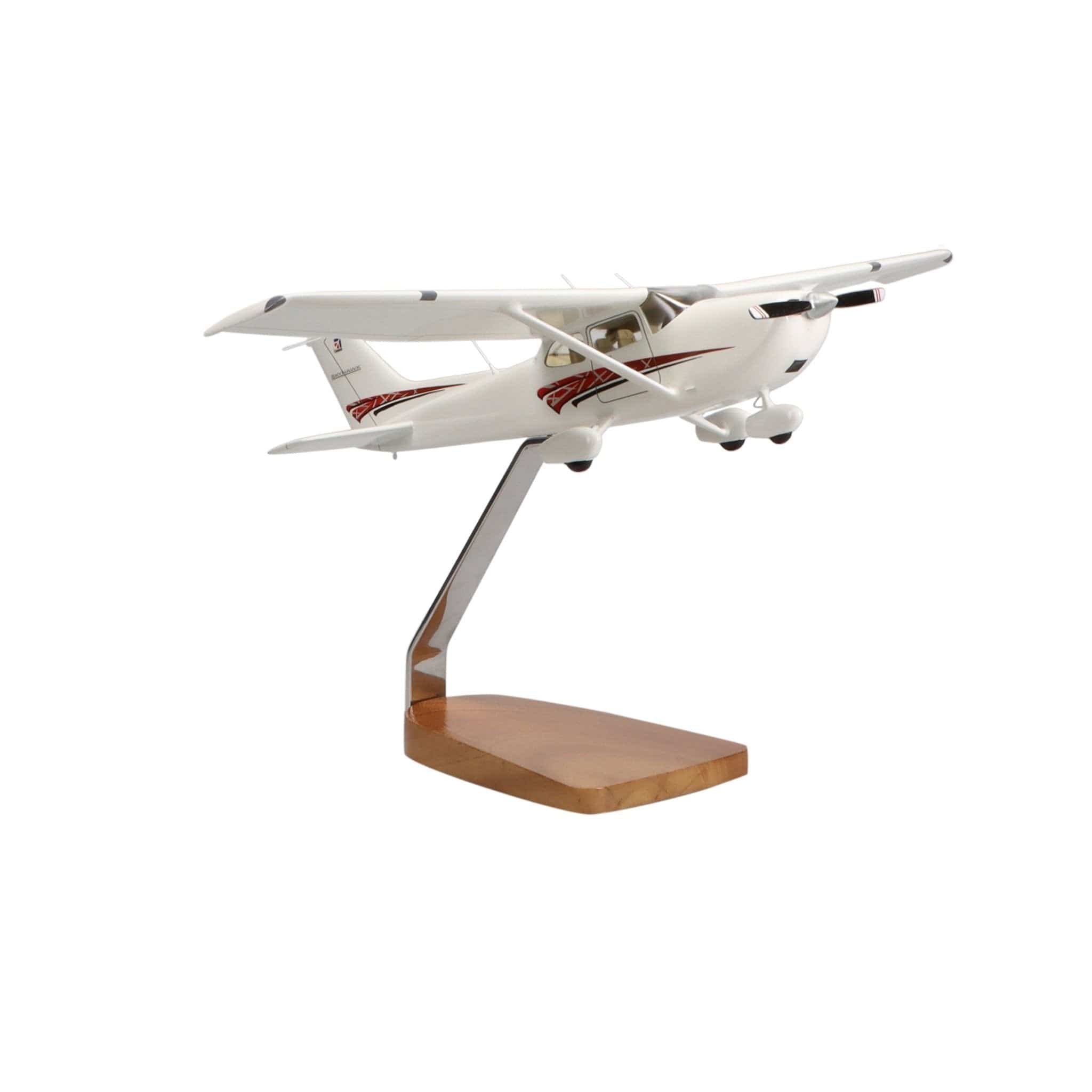In the ever-evolving world of aviation, some aircraft break free from the constraints of traditional design norms and venture into uncharted territory.
These unconventional flying machines defy expectations and challenge the boundaries of engineering. From bizarre to awe-inspiring, we will explore a compilation of the weirdest planes ever created.
Join us as we take a glimpse into the realm of 20 extraordinary and peculiar aircraft that have emerged from the minds of creative engineers over the years.
Table of Contents
- Bartini Beriev VVA 14
- Blohm & Voss BV 141
- Boeing B377PG
- Caproni CA 60
- Curtiss-Wright VZ-7
- De Lackner HZ-1 Aerocycle
- Edgley Optica
- Goodyear Inflatoplane
- Grumman X-29
- Hafner Rotabuggy
- Hughes H4 Hercules
- Lockheed Martin P-791
- Lockheed XFV
- Lun class MD-160 Ekranoplane
- NASA Ames-Dryden AD-1
- NASA M2-F1
- Sikorsky X-Wing
- SNECMA Coleoptere (C-450)
- Stipa-Caproni
- Vought V-173
1. Bartini Beriev VVA 14

Picture a bizarre-looking mashup of an airplane, submarine, and marine components, and you will begin to understand how the Bartini Beriev VVA 14 arrived at its strange appearance. The VVA 14 was a Soviet Union response to the fear of a US submarine-driven nuclear assault.
This craft was intended to be an amphibious vehicle capable of taking off from land or water. In tight places, its vertical take-off and landing (VTOL) capabilities would prove useful. The Soviets foresaw the VVA 14 gliding low over the ocean surface, conducting high-speed submarine detection missions.
The project was ultimately abandoned following the failed delivery of the vertical takeoff jet engines and the death of Bartini – one of the key engineers.
To see this strange design in all its glory, visit the last remaining model at the air force museum in Monino, Moscow.
2. Blohm & Voss BV 141

One of the largely accepted tenants of aircraft design is that the vehicle be symmetrical from side to side. The Blohm & Voss BV 141 threw that convention out the window in favor of a main fuselage that housed the power plant and a secondary crew cabin located further out on the wing.
While it may look counterintuitive, the asymmetrical design is surprisingly functional in more ways than one. It helped to offset the torque generated by the engine’s rotation while at the same time giving the reconnaissance crew a more unobstructed view from the cockpit.
Despite these positive design attributes, only a small number of BV 141s were ultimately produced since the Focke-Wulf was already doing a satisfactory job running air reconnaissance.
3. Boeing B377PG “Pregnant Guppy” or “Super Guppy”

Don’t you just love it when a weird plane has a weird name to go with it? The “Pregnant Guppy” as this modified Boeing 377 is fondly referred to, was born from NASA’s need for a way to transport bulky components for the Apollo missions. They came up with this bloated, ungainly-looking plane, but clearly, it did its job and is one of the lesser-known aircraft to play a supporting role in the space program.
4. Caproni CA 60

The early days of aviation were like the wild west, and designers could basically do whatever they wanted. There were no computer simulations to help test the feasibility of a design. You simply dreamed it up, built it, and went for it. This all-out style of hands-on learning yielded some true gems as far as weird airplanes go. Case in point – the Caproni CA 60 was built in Italy in 1921.
If one pair of wings is good, then three sets of triple wings are even better, right? Wrong…so very wrong. Still, hats off to the pilot who managed to get this 77-foot-long, 30-foot-high beast 60 feet in the air and who lived to shake his head and tell about it.
5. Curtiss-Wright VZ-7

The military is always innovating and some of the ideas that are thrown out there are a little strange. The Curtiss-Wright VZ-7 was one of those bizarre inventions. Billed as the “flying Jeep,” the VZ-7 was indeed a mash-up between an aircraft and a Jeep.
Two prototypes were delivered, but ultimately the ungainly contraption with the overly exposed cockpit didn’t catch on with pilots or with the Army, and the program was discontinued.
6. De Lackner HZ-1 Aerocycle

Built because what reckless young soldier doesn’t want to stand on top of rotating helicopter blades as part of his job? The questionable design of the HZ-1 Aerocycle sets up just that scenario.
The theory was that this craft could be a low-cost reconnaissance vehicle that would be steered by the pilot shifting his body weight, much like today’s Segue or hoverboard. Unfortunately, the reality was that the maneuverability was horrible, and soldiers were understandably reluctant to be assigned to pilot this death trap of a contraption.
7. Edgley Optica

Is it a helicopter or a fixed-wing aircraft? Well, Edgley Optica is in a class of its own, borrowing design elements from both. The cockpit looks like that of a standard helicopter, though it is mounted in front of a ducted-fan motor, fixed wings and twin booms, and a high-mounted tailplane.
Since it first debuted in the mid-1970s, the Optica design has gone through several launches and re-launches by its various owners. It continues to intrigue for its potential for border patrol and fire protection applications.
8. Goodyear Inflatoplane

The Goodyear Inflatoplane, or GA-33 as the Army called it, seems to be an example of a plan that wasn’t thought out clearly prior to execution. Goodyear pitched an idea for a compact, portable aircraft that could be dropped on downed airmen trapped behind enemy lines. The entire airplane could be carried in the back of a Jeep or truck. How is this possible? That’s the problem – as you can guess from its name, the Goodyear Inflatoplane is indeed inflatable.
Understandably, the Army eventually decided that a blow-up aircraft with a 55-mph max speed isn’t exactly a practical extrication vehicle that a pilot would want to trust his life to.
9. Grumman X-29

Did they put those wings on backward? No, that is just the design. The Grumman X-29 is one of those aircraft that look like someone took all the standard airplane parts and then assembled them in a very bizarre configuration. Instead of extending perpendicular to the fuselage or being angled slightly aft, the wings on this strange aircraft are inverted and point towards the nose, giving it quite a strange appearance.
The bizarre design was experimental, and the X-29 was an intentionally designed aerodynamically unstable craft. As the result of using this design, NASA was able to gather useful information.
10. Hafner Rotabuggy

Americans weren’t the only ones experimenting with an airborne Jeep. The UK toyed with its own version, called the Hafner Rotabuggy. This version took a Willy’s Jeep and added helicopter blades on top to make a cartoon-like vehicle of which only one was ever produced.
The single test model did carry out a successful 10-minute test flight, reaching speeds of 65 mph and an altitude of 400 feet. Still, that wasn’t enough to get this project off the ground.
11. Hughes H4 Hercules

If someone asks you what material aircraft are usually made of, “metal” seems like a safe generic answer, right? Usually yes, but in the case of the Hughes H4 Hercules, more commonly known as the “Spruce Goose,” you would be wrong.
With metal in short supply during World War II, the U.S. government contracted with billionaire aviator Howard Hughes to construct a large cargo plane capable of transporting troops and supplies from the U.S. to Europe. The catch? Hughes was forbidden to use any metal in his design.
A long 5 years later, the war was over by the time Hughes unveiled a massive craft made of laminated birch wood. While the “Spruce Goose” still holds the record for the largest wingspan of any constructed aircraft, only one was made and the lone Goose only took a single flight. With Hughes at the controls, the Spruce Goose flew a total distance of 1 mile over the ocean near Long Beach Harbor before returning to the ground.
Today, you can visit the Spruce Goose for yourself, as it is on display at the Evergreen Aviation and Space Museum in McMinnville, Oregon.
12. Lockheed Martin P-791

The classic airship gets supersized in this strange conglomeration of aircraft engineering courtesy of “Skunkworks.” The P-791 is a tri-hull design airship with disk-shaped landing cushions on the bottom. It was developed to run missions as either a heavy-load cargo carrier or an intelligence-gathering vehicle.
While the U.S. Army ultimately passed on picking up the P-791, Lockheed Martin is still working with private companies, and you may soon see P-791s flying the skies carrying both cargo and passengers in remote areas like Alaska.
13. Lockheed XFV “Salmon”

Deck space is limited on Navy ships, so there has long been an interest in developing vertical takeoff and landing (VTOL) fighters to protect convoys. The XFV, another Skunkworks production, was designed to fill that need.
Looking like a turboprop that somehow got stood on end, the XFV took on the nickname of the “Salmon” after namesake chief test pilot Hermon Salmon who made the first test flight in June of 1954.
Ultimately, the skillsets needed to pilot the Salmon during vertical take-offs and landings were simply too high, and the project was cancelled a year later.
14. Lun class MD-160 Ekranoplane

Part plane, part hover vehicle, almost part-boat, the Lun class Ekranoplane was a very visually confusing aircraft. This Soviet beast was gargantuan in size and impressive in firepower. The Ekranoplane weighed in at 350 tons and was equipped with six sunburns SS-N-22 anti-ship missile launchers along with .50-caliber machine guns and 23mm cannons.
The craft was designed to take advantage of the ground effect. In fact, it flew in ground effect all the time, at a cruising altitude of just 16 feet above the water. Not only did this improve fuel efficiency and cruising speed (350+ mph), but it also rendered the Ekranoplane virtually invisible since radar at the time (1987) wasn’t able to pick up very low-flying aircraft.
The single MD-160 that was produced remained in service from 1987 until 1997 and is now sitting inactive at a Kaspiyisk naval station.
15. NASA Ames-Dryden AD-1

Is it a fixed-wing aircraft? Well, sort of. Although the AD-1 does have a long, high wing, this single wing (known as an oblique wing) is mounted to a center point on the top of the fuselage. Rather than being completely fixed in place, the wing can pivot.
This unique design allowed NASA to test the aerodynamics of a pivoting wing, and they discovered that the wing could pivot up to 60 degrees while maintaining stable flight.
16. NASA M2-F1

Lift is usually generated by wings, but in the early 1960s, NASA started doing testing on the wingless lifting body concept of aircraft construction. The M2-F1 was part of that program. Nicknamed the “flying bathtub,” this lightweight unpowered craft helped to test the aerodynamics of a wingless aircraft like that which NASA envisioned using for spacecraft reentry vehicles. The program was a success and despite its unconventional look, the M2-F1 was a key proof-of-concept in the eventual development of the space shuttle.
17. Sikorsky X-Wing

Luke may have had his X-wing fighter a long time ago in a galaxy far, far away, but we humans didn’t venture into X-wings until the late 1980s. The Sikorsky X-wing is an airplane-meets-helicopter mashup intended to combine the best of both worlds with the speed of a jet paired with the vertical takeoff capabilities of a helicopter.
Funded by DARPA and developed for both NASA and the US Army, the X-Wing may have had potential, but the program was scrapped amid budget cuts.
18. SNECMA Coleoptere (C-450)

While we Americans were playing with VTOL aircraft in the 50s, the rest of the world was doing the same. The French foray into this arena gave birth to a very weird and ungainly “plane” known as the SNECMA Coleoptere or C-450. This annular wing craft placed a jet cockpit atop a barrel-shaped fuselage housing a turbo reactor.
As with the American VTOL crafts, the pilot had to have a high degree of skill to manage the tricky vertical landings and the transitions between vertical and horizontal flight. On the C-450’s 9th test flight, the pilot lost control during the approach to landing and was forced to eject from the crashing aircraft. This brought a quick end to the program.
19. Stipa-Caproni

In 1932, the Italians started tinkering with the fuselage design of traditional aircraft. The engineer – Luigi Stipa – decided that a long fuselage wasn’t necessary, and it took up too much space in aircraft carriers, so he basically cut it off just aft of the wings, and the very bizarre-looking Stipa-Caproni was born.
This experimental aircraft had a stubby, barrel-shaped fuselage that really did look as though someone had hacked off the rear of the craft. The hollow fuselage enclosed both the engine and propeller so that the aircraft functioned much like a single ducted fan. This was intended to increase thrust. The resulting Stipa-Caproni was quieter than aircraft of the time and had a slow landing speed of 42 mph. Unfortunately, in addition to improving thrust, the “intubed” propeller design also caused extensive drag, limiting the Stipa-Caproni’s top speed to just 81 mph.
Ultimately the Italian Royal Air Force decided not to move forward with the design, so only a single unit was built, but the design did influence future jet engines.
20. Vought V-173 “Flying Pancake”

The U.S. Navy’s official name of this weird aircraft is the Vought V-173, but everyone knows it as the “Flying Pancake” thanks to its strange round, flying saucer-like profile. The purpose of the odd design was to provide the Navy with an aircraft capable of taking off and landing in tight areas. The prototype performed extremely well with low take-off and landing speeds thanks to the lift-generating design of the disk-shaped aircraft body.
Funding was given for an improved version with a target landing speed of 20 mph and a top speed of an impressive 425 mph. Sadly, the initial re-design proved flawed with excessive engine bay vibration, and by the time this was corrected, the war was over and the military was focused on jet aircraft development instead.
Like Our Content?
Don’t miss out on the latest aviation updates. Sign up for our newsletter to receive coupons and special promotions!
100% free, Unsubscribe any time!








8 comments
Anonymous
There’s not enough about the AD-1 :(… the OBLIQUE WING is an amazing piece of tech.
Noah
Pov: me making planes in roblox
Tom Dennis
The info on the X-29 is misleading. The design was always flown as experimental (indeed by NASA) and it was successful in that it gave plenty of information on aerodynamics, as intended.
Andrew
How did these become real 💀💀💀💀💀
Pepe
What is this? The planes look like they were made by a 1 year old.
Pepe
What is this? The planes look like they were made by a 1 year old.
ur mom
Can u explain how Vought V-173 flies using the 4 forces of flight
Stephan Wilkinson
The Lockheed XFV-1 never took off properly, from a tail-sitting position. It only took off conventionally—horizontally—sitting atop an odd landing-gear cradle. The Convair Pogo, its competitor, did take off (and land, which is the far more difficult act) vertically a number times, in the hands of my late friend Skeets Coleman.